Drunken Sailors going about their lives, spending money, moving the economy forward.
By Wolf Richter for WOLF STREET.
Retail sales rose 0.5% in July from June, and June’s growth was revised up to 0.9%, seasonally adjusted. That’s solid growth.
But retail sales have gone through some gyrations so far this year, month-to-month: In January, they plunged from December, in February they were up just a hair, in March they spiked, in April they dipped, in May they plunged, in June they spiked (as revised higher today), and in July, they increased solidly.
These gyrations this year were caused by massive sales at auto dealers in March, due to tariff front-running and a strong tax-refund season (down payments). Auto dealers are the largest category of retailers (19% of total retail sales), and they move the needle. Then, auto sales backed off from that spike, which caused month-to-month retail sales to sag in April and May. And in June and July, consumers reverted to the solid-growth trend.
Year-over-year, retail sales in July rose 3.9% seasonally adjusted. And not seasonally adjusted, they rose 4.3% to $744 billion, according to the Census Bureau today.
The three-month average (red in the chart below) irons out those gyrations. For July, it includes the big drop in May, and still rose by 0.2%. Year-over-year it was up 3.9%. This is solid growth.
Inflation plays only a small role in retail sales because inflation in goods that retailers sell has been relatively subdued this year. Inflation is in services which dominate consumer spending, but services are not part of retail sales. Prices of some goods categories are down year-over-year, others are up.
The CPI for durable goods (motor vehicles, consumer electronics, furniture, appliances, sporting goods, etc.) rose 1.2% year-over-year. The CPI for nondurable goods (food, gasoline, apparel, shoes, household supplies, etc.) is up only 0.5% year-over-year (details and many charts here).
The three-month average shows the solid relatively steady growth. There is nothing wrong with US consumers. They’re just fine; employment is at a record, they’re making more in wages and salaries than ever before; unemployment is historically low, layoffs are low, asset markets are soaring, and the $4.6 trillion that households have in money market funds are still earning around 4% in interest. So there isn’t really anything surprising about consumers continuing to spend money at a solid pace at retailers.
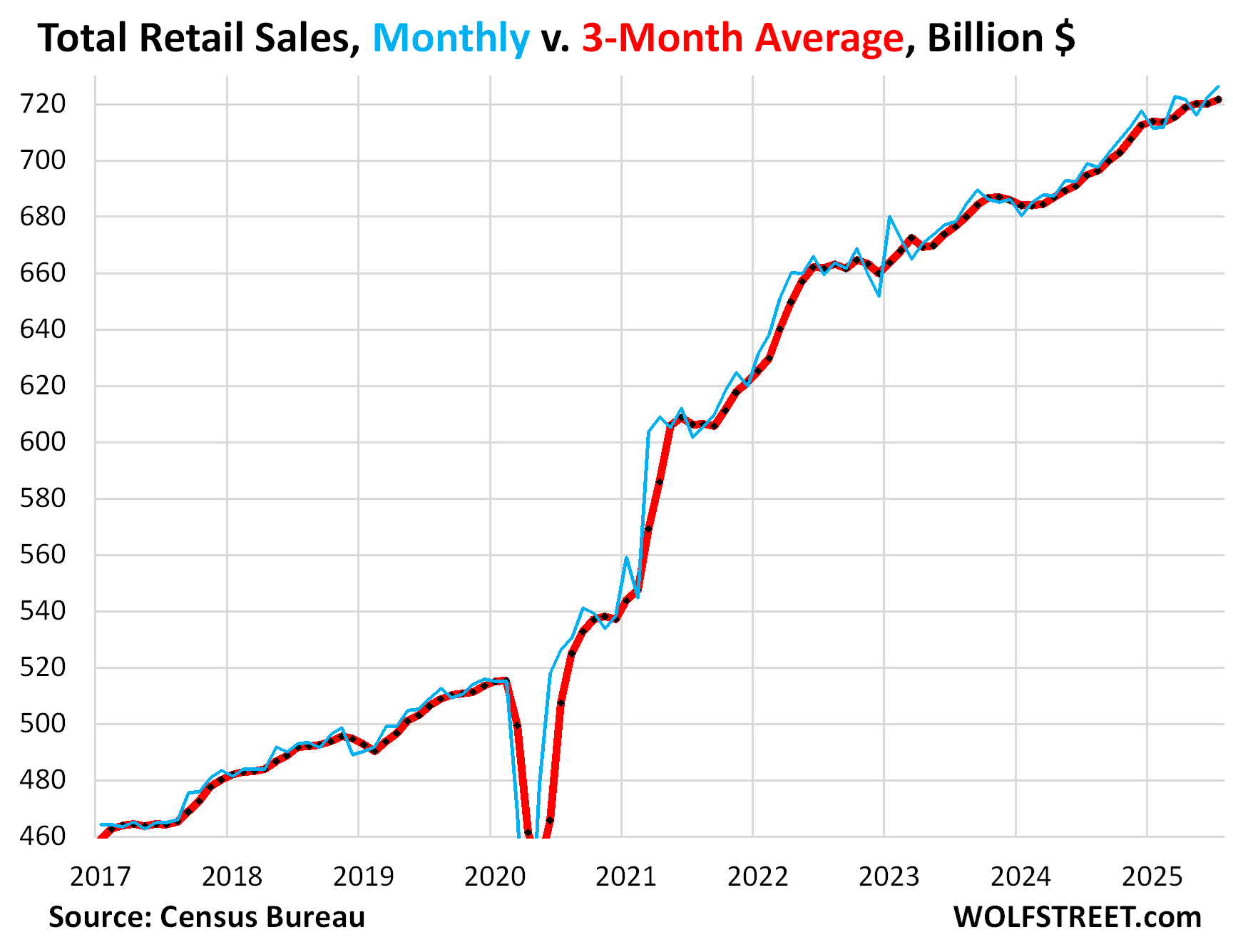
Sales at auto & other motor vehicle dealers – new & used vehicles, RVs, motorcycles, ATVs, snowmobiles, etc. – jumped 1.7% in July from June to $128 billion, seasonally adjusted, and were up 4.9% year-over-year. Note the gyrations of the month-to-month sales this year (blue line in the chart below).
This does not include parts dealers. With sales at parts dealers included ($11 billion), sales at Motor Vehicle and Parts Dealers rose 1.6% for the month and 4.7% year-over-year, to $139 billion, accounting for 19% of total retail sales.
The three-month average (red) irons out only part of those gyrations:
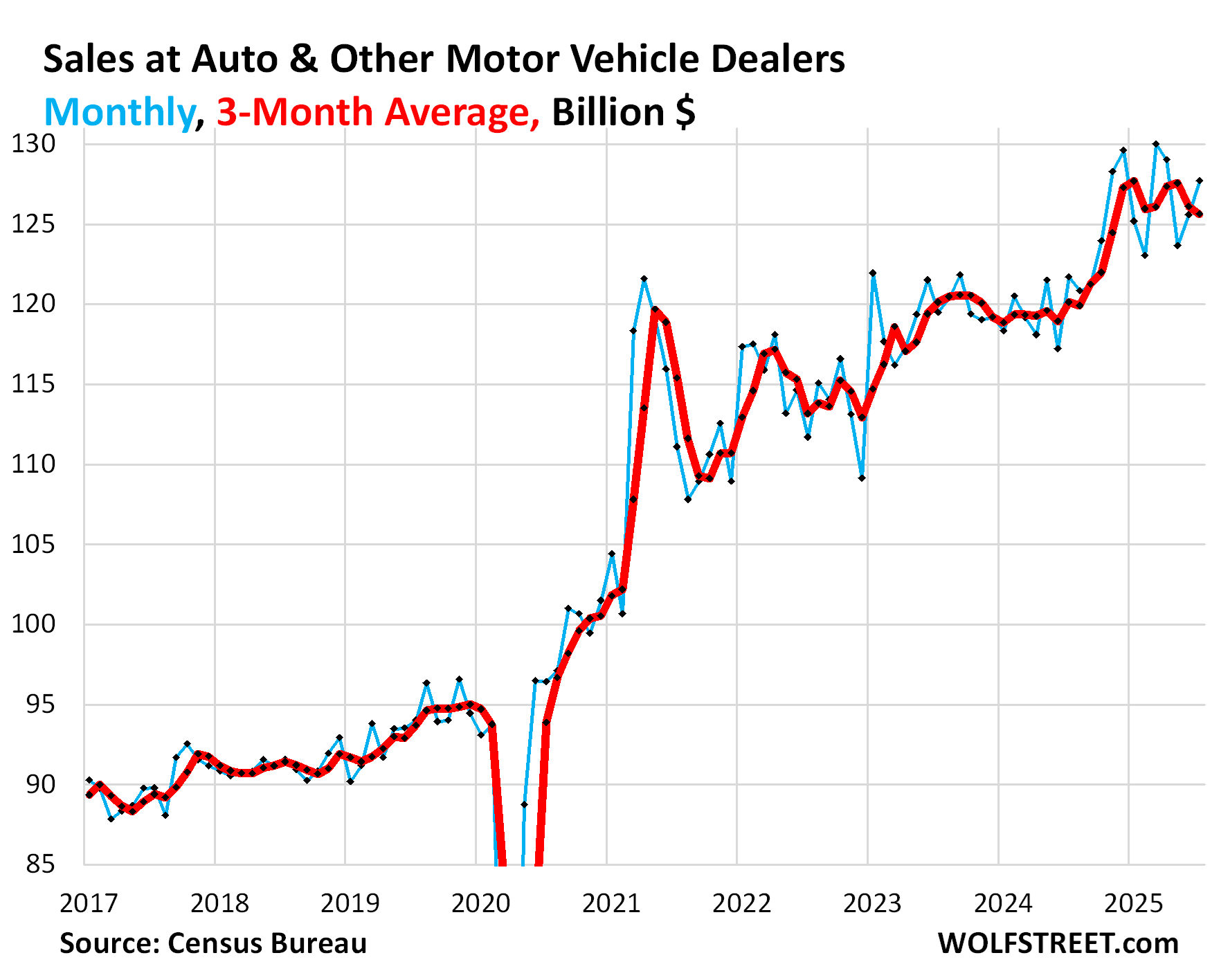
Ecommerce (#2 retailer category, 17% of total retail) has been growing at a strong pace and continued to do so in July, up by 0.8% from June, seasonally adjusted, and up by 8.0% year-over-year, to $127 billion.
Three-month average sales: +0.8% month-to-month and +7.0% year-over-year.
No sign of consumer weakness here, just growing at a relentlessly strong pace, as more and more of the retail trade shifts to ecommerce from brick-and-mortar stores:
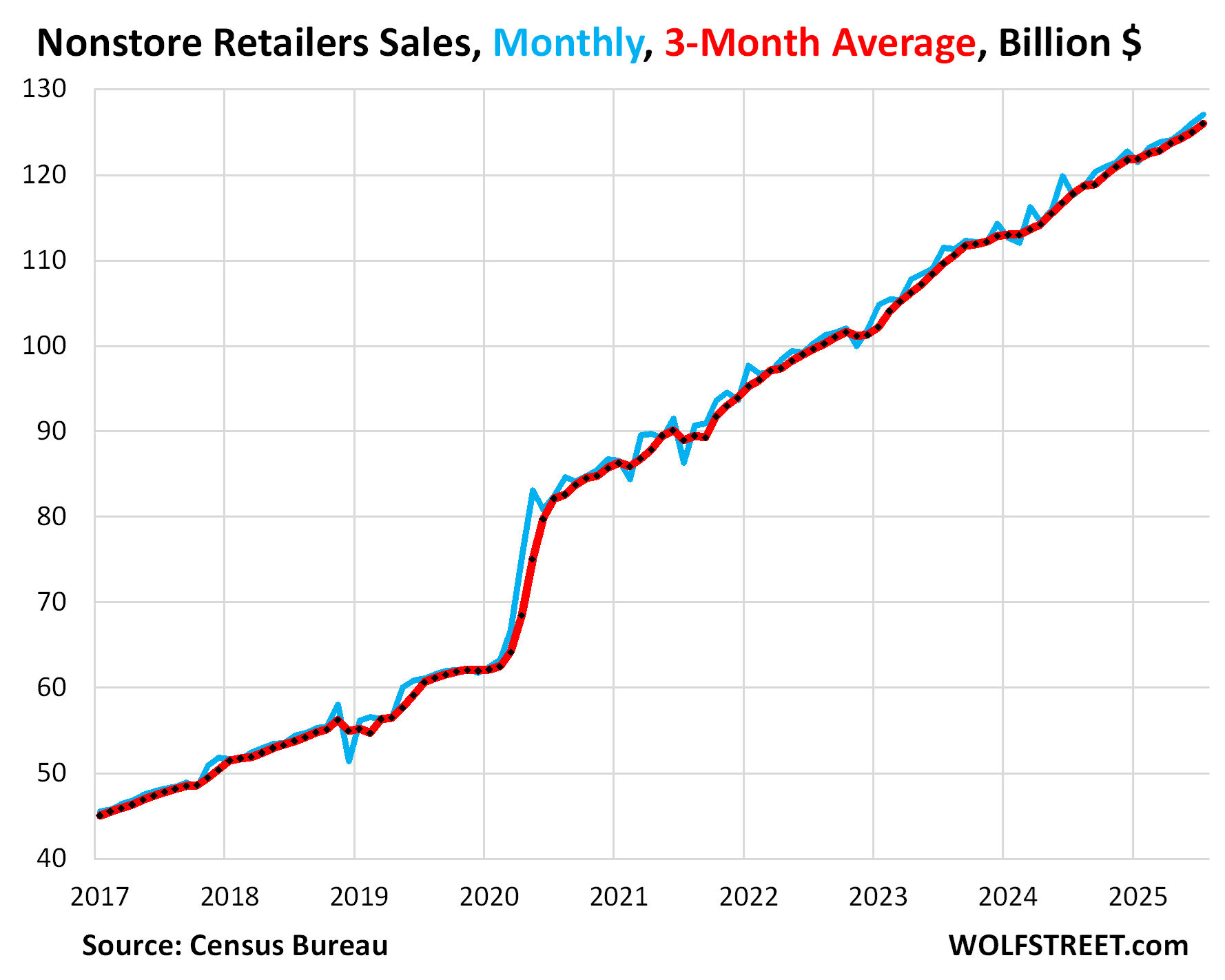
In restaurants and bars (#3 category, 13% of total retail), sales dipped by 0.4% month-to-month, from the record in the prior month, to $98 billion, and were up 6.6% year-over-year.
Three-month average sales: +0.01% month-to-month and +6.1% year-over-year.
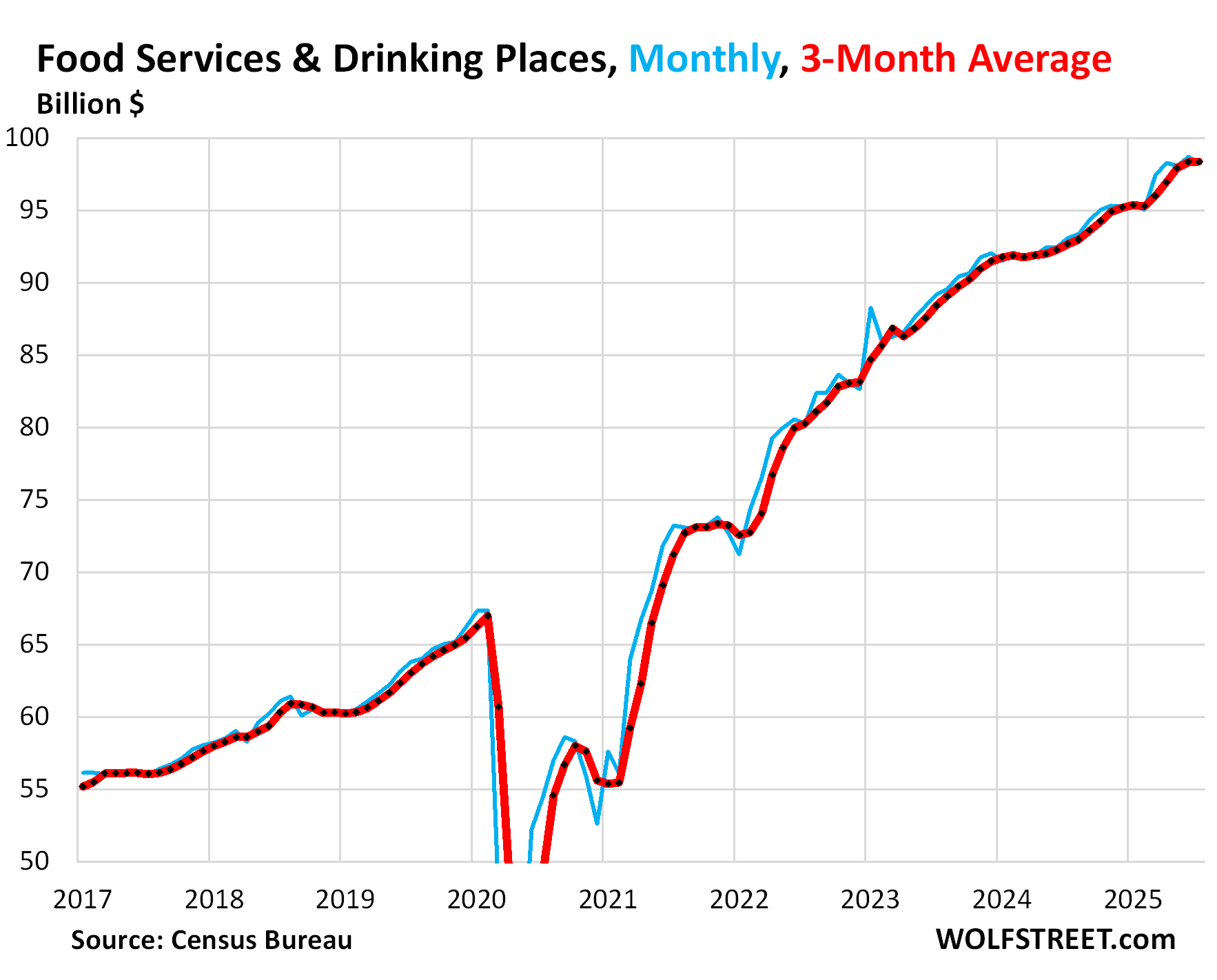
At food and beverage stores (#4 category, 12% of total retail), sales rose by 0.5% month-to-month to $85 billion, and by 2.5% year-over-year.
The three-month average sales: +0.3% month-to-month and +2.4% year-over-year.
More and more grocery sales have wandered off from grocery stores in this category to general merchandise stores, such as Walmart and Costco (see “general merchandise stores” below) and to ecommerce (see “nonstore retailers” above).
Food purchases have also wandered off to restaurants, a trend that has been playing out for decades as our Drunken Sailors, as we’ve come to call them lovingly and facetiously, have turned eating into an outside-the-home event (see “restaurants and bars” above).

At general merchandise stores (#5 category, 11% of total retail), sales rose by 0.4% month-to-month to $77 billion, and by 2.3% year-over-year.
Three-month average sales: +0.3% month-to-month and +2.4% year-over-year.
Walmart is the largest grocer in the US, and its grocery sales are included here. But its huge ecommerce operations are included in “nonstore sales” above:
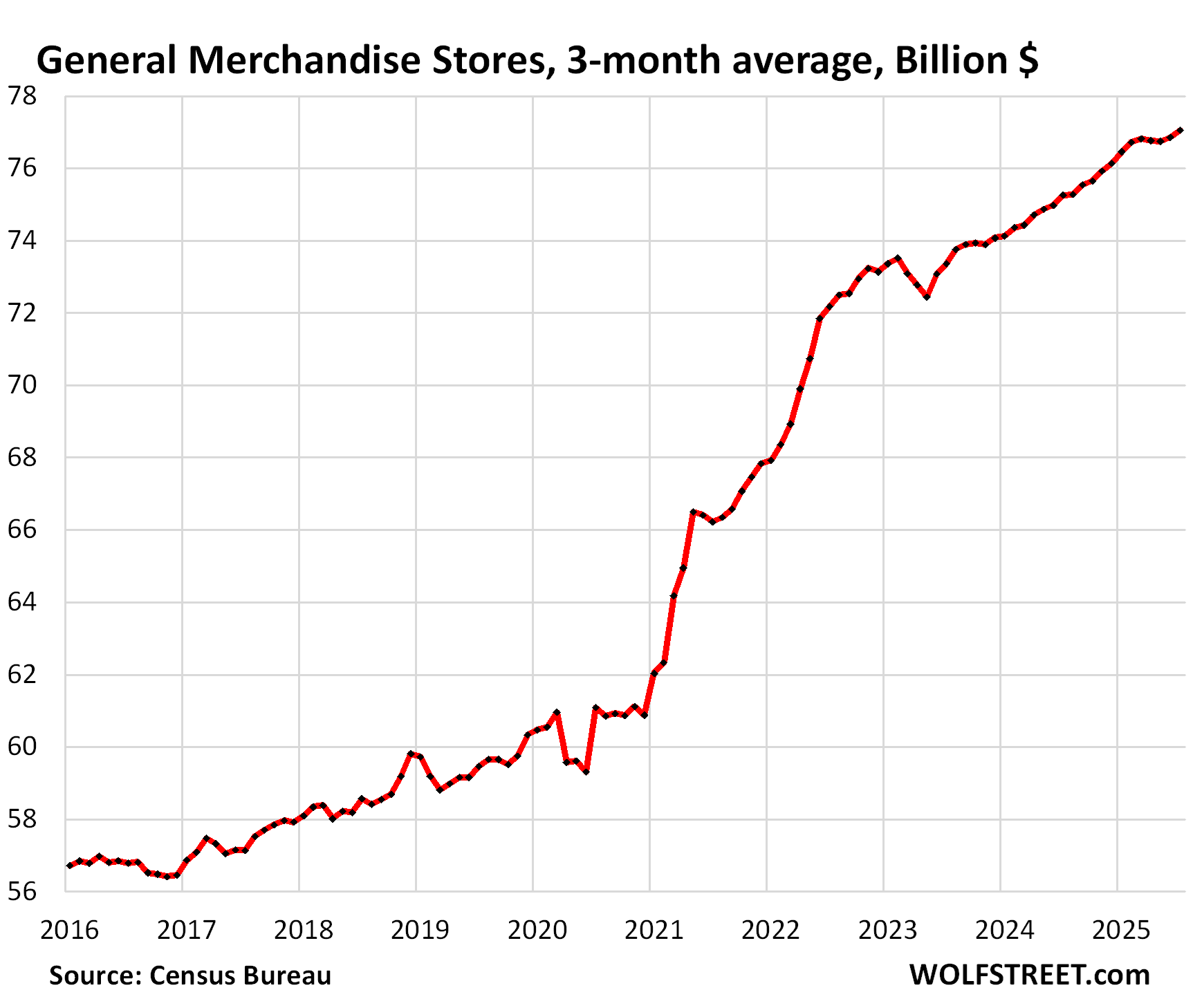
At gas stations (#6 category, 7% of total retail), sales move in near-lockstep with the price of gasoline. The price of gasoline started plunging in mid-2022 and then continued to zigzag lower. And gasoline sales in dollar terms have followed the price down.
The three-month CPI for gasoline plunged by 1.2% in July and by 9.9% year-over-year (dotted purple).
Three-month average sale: +0.2% month-to-month and +3.9% year-over-year, to $51 billion (red).
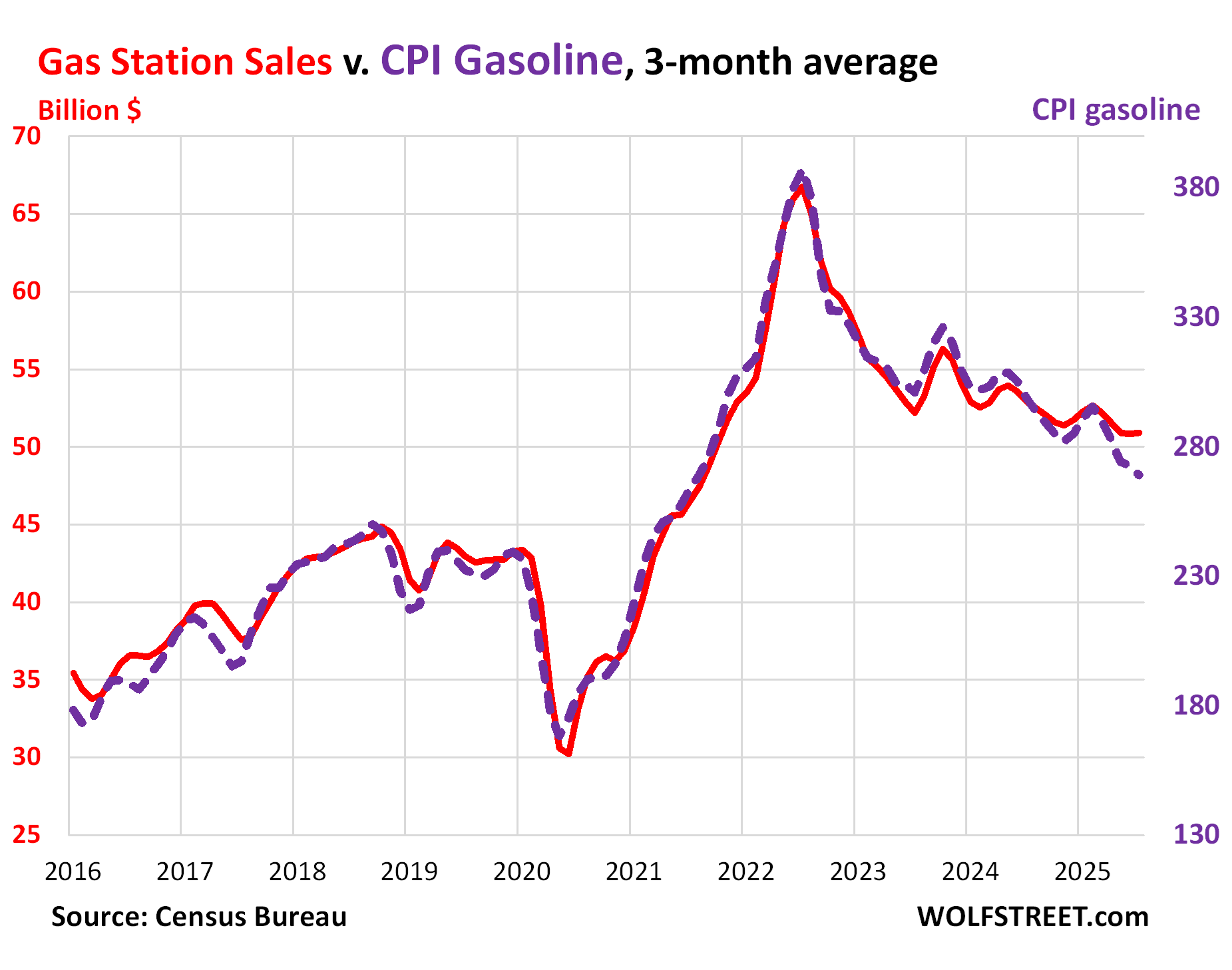
At building materials, garden supply and equipment stores (#7 category, 6% of total retail), three-month average sales: -0.8% month-to-month and -1.3% year-over-year to $40 billion.
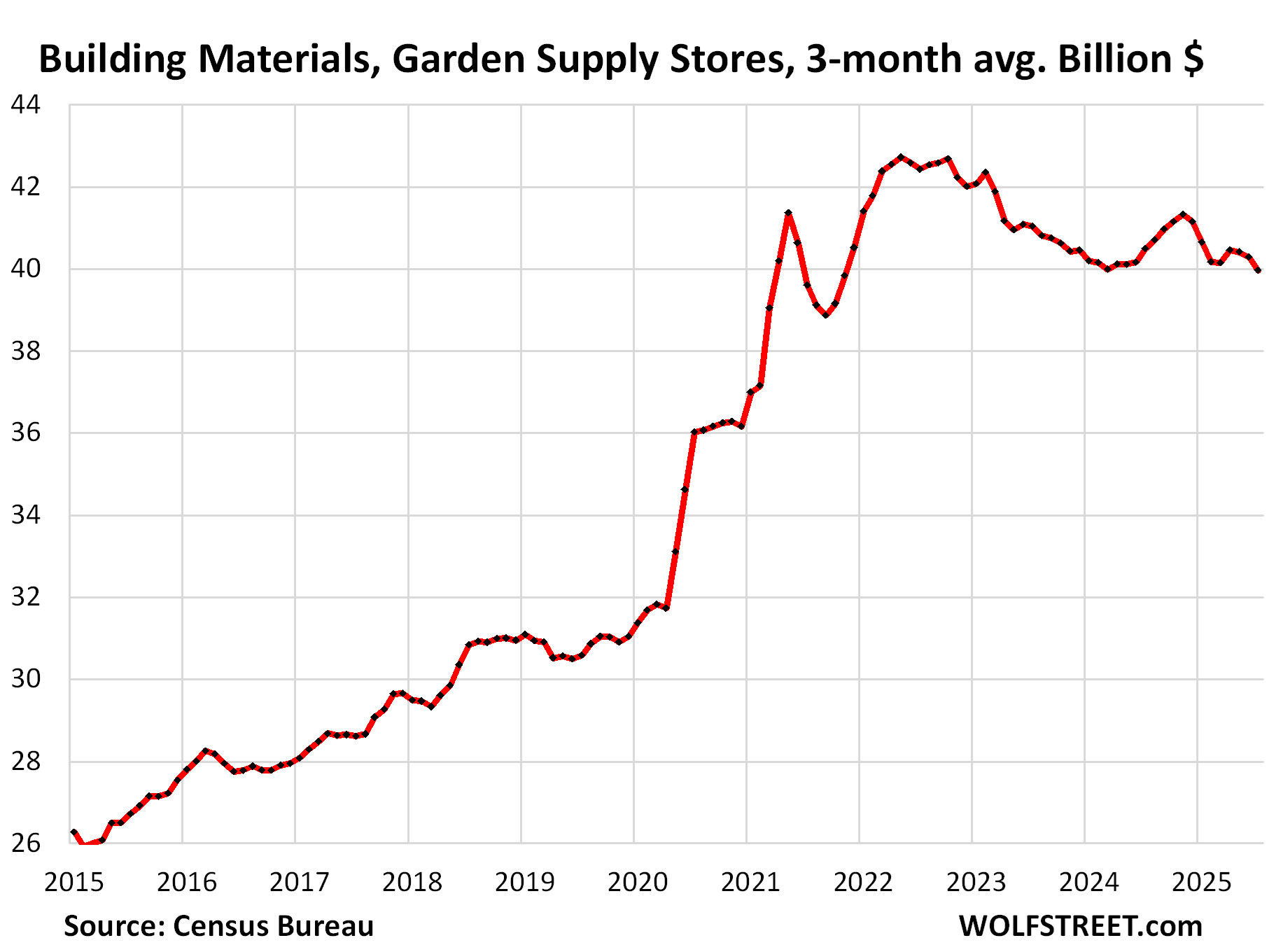
At health and personal care stores (#8 category, 5% of total retail), three-month average sales: +0.7% month-to-month, and +7.9% year-over-year to $39 billion.

At clothing and accessory stores (#9 category, 4% of total retail), three-month average sales: +0.8% month-to-month and +4.5% year-over-year, to $26 billion.
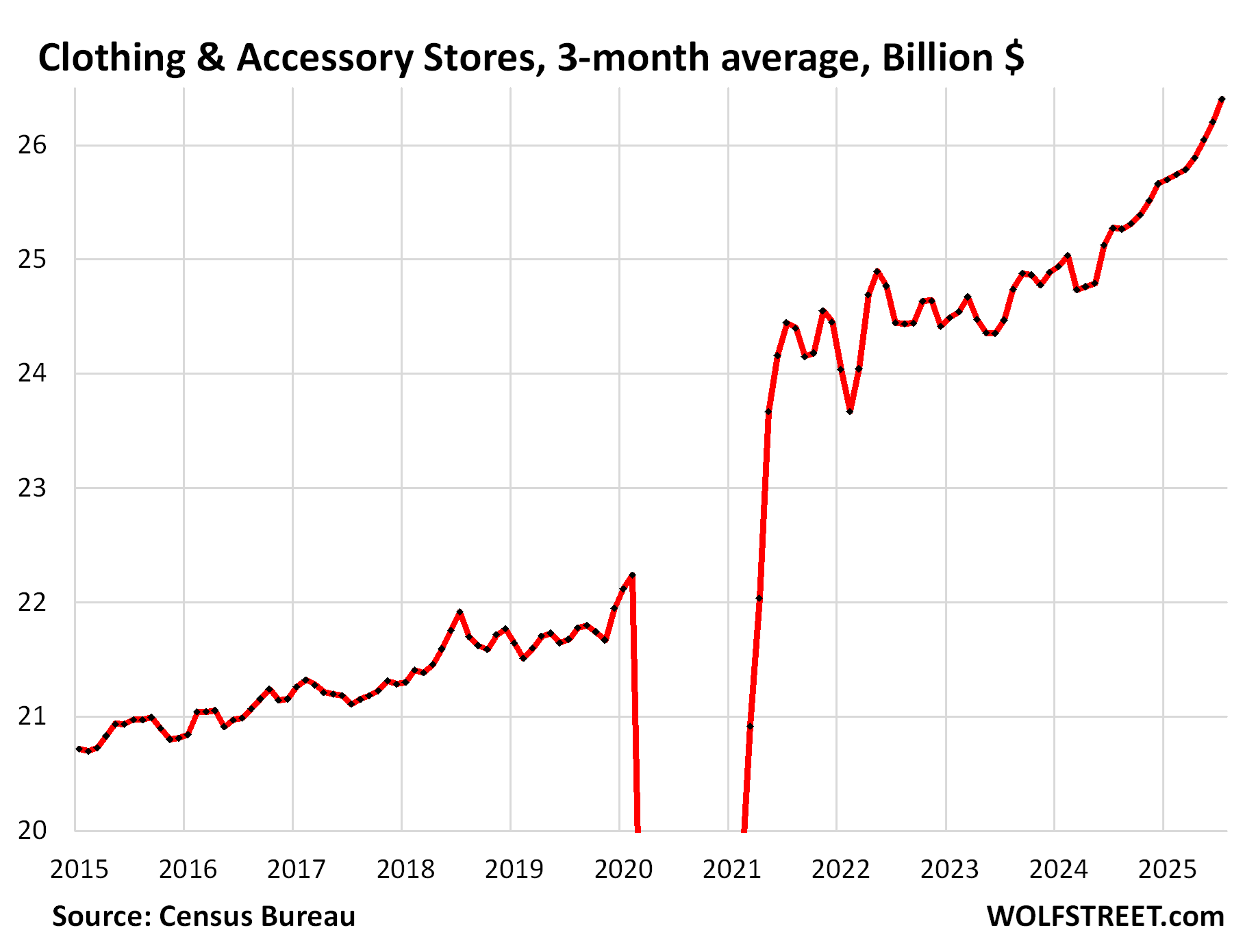
Our Drunken Sailors are out there spending, even if they’re in a sour mood. And why shouldn’t they? Employment is high, wages are rising, and their credit is in good shape except for student loans that suddenly count again as delinquent. They’re sitting on trillions of dollars in interest-earning cash, and asset prices have soared, and unless something big changes, they’re going about their lives and moving the economy forward.
Enjoy reading WOLF STREET and want to support it? You can donate. I appreciate it immensely. Click on the mug to find out how:
![]()


Modern day financial Sodom and Gomorrah,
If it pumps the dopamines….Charge it…..Worry about the financial damage later.
Have a fantastic weekend ! 🍻
It’s not quite that bad.
Sure, I do think there should be much stricter consumer lending standards, ones strict enough that a good proportion of people wouldn’t be able to borrow at all.
But the US consumer, as a whole, is in much better shape than it was in the 2000s. Wolf has put graphs with this on this site.
You don’t read any other articles?
209er
🤣 consumers’ balance sheet are in great shape. I told you where the spending money is coming from: record employment with record salaries and wages. And consumers still save some. Soaring asset prices also help with big-ticket items, such as cars. Read the article.
Here is the household debt to income ratio:
https://wolfstreet.com/2025/08/05/household-debts-debt-to-income-ratio-serious-delinquencies-collections-foreclosures-bankruptcies-our-drunken-sailors-debts-in-q2-2025/
That chart just shows how nuts the great financial crisis was. Holy hell.
Yes, it was bad all around, which is why we got the GFC.
Now it’s the federal government with a high debt to income ratio.
Wait, huh? I don’t see any charts which show the 2008 GFC, I only see the ridiculously stupid money-printing COVID era.
Speaking only for myself, I’ve achieved all of my 2025 investment goals already, so I think some retail therapy for “pumping the dopamines” is in order! Also making sure I have spare cash for my next donation to Wolf…
Have a great weekend, everyone!
Most credit card holders use credit cards as a monthly payment mechanism and pay off their balances in full every month.
Clark Howard (the consumer guy) recently stated that there are 2 types the credit card companies cater to.
1. The cash back crowd, these people work to get their cash back rebates from spending a ton on Everything! The best of these people hop cards left and right to maximize their bonuses. They never hold a balance and CC companies gain no interest from them. They do however gain fat transaction fees.
2. The people with their backs to the wall. They hold large balances of CC debt. Mostly they make their CC payments monthly. The CC companies have their knives out for these people and treat them rough, like the prisoners they are.
“You want a what?! A lower APR? get back in your hovel you scum!”
CC companies make a ton of interest off of these customers.
Credit card companies make the most off the people that use their credit cards for nearly all purchases to earn cash back or miles or whatever, and then pay them off every month, and never pay interest. Banks earn the swipe fees on close to $6 trillion a year that people run through their credit cards, nearly all of which gets paid off every month.
From Merchants Payments Coalition:
“High swipe fees, which have jumped 70% since the pandemic and hit a record $187.2 billion in 2024, contribute to enormous profits for the card industry. Profits are even higher at Visa, which had quarterly profits of 56% as of April, and Mastercard, which had 45% as of May. By contrast, net profits for merchants average about 3%.”
Banks make a smaller amount on the interest they charge on the relatively small balances that accrue interest.
We have one card that gets us 2% cawh back on everything (with no max) and the Amazon card that gets us 5% back on Amazon purchases. We don’t “work” to charge a lot but we charge more per “two months” on average than I made per “year” on average when I craduated from college in the early 80’s. Anyone know of a 3% on everythong card?
Mr. Wolf: “I told you where the spending money is coming from: record employment with record salaries and wages.”
This is exactly where the services inflation originates.
Yes, there’s that dynamic too.
For some reason though, most people I’ve spoken to feel like they’re worse off than in 2019. They might be objectively wrong, but that’s how people seem to feel.
If you are trying to buy a home, you are much worse off, 30-50% higher price plus twice as high on interest rates for much of the country, and if you are lucky, pay is up 20%. But be patient, prices are moving down now in lots of places.
Because the gap between the obscenely wealthy and everybody else is bigger than ever, and big ticket items/assets, etc. have never been more expensive.
I trust Wolf and his charts more than anybody else, but for some reason I think they’re not capturing the true financial pain that a large percentage of people are feeling due to inflation.
@Depth Charge I’m pretty close to “obscenely wealthy” but I still feel like I am worse off than 2019. On paper I may be better off (with ammost every property worth at least a million more) but I have less cash flow (with expenses going up faster than rents).
Depth Charge
Look, we had an inflation shock from late 2020 through mid-2023 or so, when there was a lot of inflation 5%,7%, up to 9%, then 7%, 5% etc. During that 3-year period, prices rose by 25%. All my inflation charts show that. Some prices rose a lot more, such as used cars (50%+), insurance, auto maintenances, beef, coffee, etc. Some prices rose less. This is all documented in my inflation charts.
Wages rose too during that time from late 2020 through mid-2023, but not nearly enough, so wage earners fell behind. And that’s brutal, that’s a reduction in the standard of living, and that was clear in all my charts that dealt with it.
But then prices rose much more slowly, inflation was running in the 3% range, some prices actually fell by quite a bit, and wages grew faster than prices increased, and wage earners started catching up.
Then there’s another issue: age.
Younger workers, workers in their prime, got promoted, got trained, switched jobs to get better jobs, got poached and recruited away from current jobs, and changed industries, during the labor shortages, and they had big pay increases, and caught up some time ago.
But older workers often don’t get raises anymore, they’re getting aged out of the workforce. Younger managers try to get rid of them. Companies try to get rid of them by not promoting them, by not giving them a raise, by making them miserable, by making them feel lucky to even have a job. And when they get laid off, they cannot get a job anymore. They’re ignored.
That’s especially true in tech. This has nothing to do with the economy. It’s age discrimination, the most tolerated and often encouraged form of discrimination (though it’s illegal). And it has been around forever.
So many older people (many readers here) did not benefit from the wage increases – they just got the price increases without the wage increases. And that’s where a lot of the pain is. And that’s very typical. That’s why older people hate inflation so much. But inflation is a much lesser issue for younger people. Quite a few of them doubled their pay over a three-year period by switching jobs multiple times, they blew right through this inflation.
But again that’s age discrimination, and it has always been that way, and it has always been painful. My dad went through it, my wife’s dad went through it, now friends of mine are going through it.
The people that might do better and be happier when they’re still working at an older age are people at the top of the corporate hierarchy, politicians, and people who have their own shops.
But this site isn’t about social studies or social justice. It’s about the economy and finance, and that’s how the economy has always worked, that’s the dynamics of the American economy, rampant age discrimination is part of it, that’s not new, and everyone knows it. And that kind of stuff doesn’t belong into my articles.
Atlantic: The American Car Industry Can’t Go On Like This
Ford is taking drastic steps to compete with China’s cheap EVs. Even that might not be enough.
Last year, Ford CEO Jim Farley commuted in a car that wasn’t made by his own company. In an effort to scope out the competition, Farley spent six months driving around in a Xiaomi SU7. The Chinese-made electric sedan is one of the world’s most impressive cars: It can accelerate faster than many Porsches, has a giant touch screen that lets you turn off the lights at your house, and comes with a built-in AI assistant—all for roughly $30,000 in China. “It’s fantastic,” Farley said about the Xiaomi SU7 on a podcast last fall. “I don’t want to give it up.”
Farley has openly feared what might happen to Ford if more Americans can get behind the wheel of the Xiaomi SU7. Ford was able to import a Xiaomi from Shanghai for testing purposes, but for now, regular Americans cannot buy the SU7 or another one of the many affordable and highly advanced EVs made in China. Stiff tariffs and restrictions on Chinese technology have kept them out of the U.S. If things changed, Ford—along with all other automakers in the U.S.—would be in serious danger. Chinese EVs can be so cheap and high tech that they risk outcompeting all cars, not just electric ones. In the rest of the world, traditional automakers are already struggling as Chinese cars hit the market. In Europe, Chinese brands now have roughly as much share of the market as Mercedes-Benz. “We are in a global competition with China,” Farley said earlier this year. “And if we lose this, we do not have a future at Ford.”
It appears obvious why Ford (Found on Road Discharged) is now failing so very badly. I would suggest that Jim Farley go drive a few BMWs to find out what cars are all about – or else just close down their doors for good.
I worked for GM as an engineer in the 80’s and left (partly) because I could see the Japanese were kicking our tails. I love cars and the auto industry but then came the Koreans. They make some very nice automobiles now. So suddenly the Chinese are exploiting the “electrification” of personal transportation at levels the US manufacturers never anticipated. Self-driving, automated everything. I’ve read that the self-driving cars in China are so prevalent that they are moving towards a signal/indicator that robot cars are without a driver. With Chinese industry being one of the worst climate affecting countries for smog and awful air breathing quality, it’s hard to argue with their move away from ICE.
I love America but I don’t see how anything we are doing now is going to make us a car making powerhouse in the next 10 years.
@Chase D I graduareed from college in 1984 and bought a new 4cyl Porsche 944, a friend bought a 1984 4 cylCamaro that was such a piece of crap I was certain America was doomed. My girlfriend at the time who also graduated bought a 1984 Honda CRX that had even higher quality than the Porsche and Camaro. I bought my first American care ever a few years back when I bought my wife a Lincon Navigator and it is a nice car (with a LOT more space & seats than her old Range Rover). American fars are a LOT better than the 80’s but still not as good as Japanese cars and German cars (I have two Japanese SUVs two German cars and a British SUV (that is lower quality than even the worst American car – but I still love it)
People have dismissed Chinese Science and Engineering capabilities as not up to par with the West. That they are just really good copiers. Well, I got bad news for those people. As an engineer I see products coming out of China that have no equal anywhere. Yes they copied but now they are innovating and creating at a fast pace and I don’t think the West can keep up. The really bad news will be for our defense and armed forces. Gee, those men who transferred our technology and production from our country to China were real geniuses (sarc). Our children and grandchildren will pay the price for this.
Do you think the greedy old codger CEO who farmed the toothpaste out to China really cares that his grandkids are being poisoned? ‘I got mine, so f**k ’em’ is his mentality. He’d sell his own newborn for a buck.
The Lucid Gravity has a 926-volt architecture. As I have commented before, my dream car would be a small and light weight Lucid sports coupe that wold be quick in acceleration, but also agile. Agility and mass are somewhat mutually exclusive. A 2,500 kg vehicle that’s quick off the line has no appeal for me.
As reported by Patrick George on 7 May 2025 from the Shanghai Auto show: BYD has a 1,000-volt architecture car that has “Megawatt Charging.” 1,000 volts delivering 1,000 kilowatts of electric power that will juice up the batteries for a 200 mile range in 5, yes 5, minutes.
First, BYD developed 1,500-volt silicon-carbide power chips, redesigned electric motors and the motor controllers. The challenges to this system are electrical, magnetic mechanical and thermal. In other words, a shit load of physics problems all combined together.
The batteries are 100 kWh lithium-iron-phosphate units. They have less power density than nickel manganese cobalt batteries, but they last longer. The batteries also have a unique set of electrolytes, separators and electrodes that reduce internal resistance. Internal resistance during charging = heat.
If you’re following this so far, add in another step that’s needed. The whole system has to be cooled, or refrigerated very efficiently and with a huge amount of thermal energy pulled out of the batteries while this super fast charging happens.
Mr. Farley, is Ford doing this? Because automotive engineers in China are not only doing it, they’re working on making cars that can be manufactured at reasonable prices with this. Hello?
Back to my dream car; the power, quickness, speed and agility that I get riding my six year-old, 209 kg Tuono V4 is what I want from a car. I won’t hold my breath waiting for one though.
When I ride her at 50 mph in second gear, Thunder (Tuono in Italian) is Lightning – ready to strike! Yes, I know. I’m silly.
Some credit to Ford should go out, though. Check out Max Verstappen and Chris Harris in the new Mustang GTD. This machine bends the laws of physics between mass and agility.
Not silly, powerful. I’m in awe of you, always have been. And envious, too.
Wolf – i sure wanna get a massive pair of rose colored glasses. Where did you buy yours?
Walmart.com, 100% organic plastic, three lenses, the center lens for extra bright-rose vision, AI-powered nose-pads, crypto-enabled, on sale for $1.99. Walmart ate the tariffs.
That’s why I’m always so offended when people call me permabear. I just don’t get why these people can’t see my rose-colored glasses.
Wolf, you slay me. Haters gonna hate. It is rough living in a world where data that contradicts people’s n=1 experience must be dismissed as hallucinations (or glasses of the rose variety). I laughed, twice, reading your response.
I don’t see drops in retail spending anytime soon.
With the housing market essentially locked up those dollars are being funneled elsewhere.
Government is pressing harder on the debt pedal so it’s kind of hard to have a recession.
FED hasn’t got Inflation under control yet and can’t raise interest rates otherwise borrowing costs go up; can’t really lower them either.
If and when the Government has to stop just the $2 trillion overspending the real pain will begin and I think they know that.
Monetary flows, the volume and velocity of means-of-payment money, the 10-month rate-of-change in the proxy for R-gDp, is still positive (courtesy of BCA in Canada). The latest Atlanta GDPnow estimate is 2.5 percent.
My personal feeling is that the consumer is in great shape, and their balance sheets are in great shape, because all of the pain has been transferred to the federal debt.
All of the federal dollars that are borrowed every year (approaching $3 trillion now) ultimately end up in someone’s wages, or in the wealth of the rich. The latter spends that money, and that ends up in someone’s wages.
The “big beautiful bill” making the tax cuts permanents will keep the money flowing. Lower income households don’t benefit much from it, but they have to spend every penny anyway no matter what (perhaps having to cut back on MacDonald’s now), middle income earners benefit somewhat and can continue to spend (maybe they have to contend with a used truck now, instead of a brand-new 100k+ rig, but still, life is not bad), and for the higher income brackets life is the best it ever has been, and they can gamble even more recklessly (Ethereum is hot).
Yep. The top 1% has about 50% of the wealth, and a lot of political power, so investors believe Congress and the Fed will jump in to bail out the stock and housing markets, if need be.
Obviously, the Federal Reserve will do no such thing when housing prices fall as they are and will and the Federal Reserve has nothing whatsoever to do with the equity (stock) markets.
Cutting back on McDonald’s — cutting spending there to zero — is one of the best things anyone can do for their health. And Americans are starting to get it maybe.